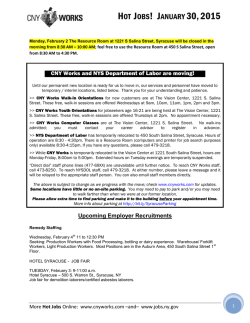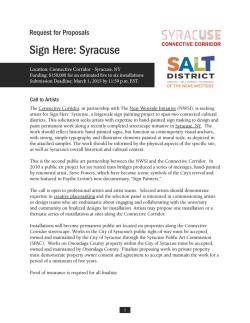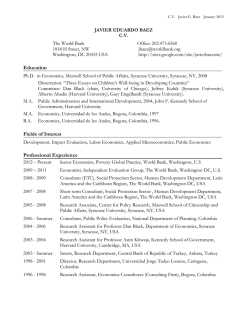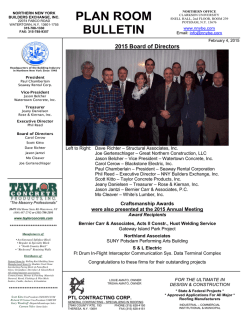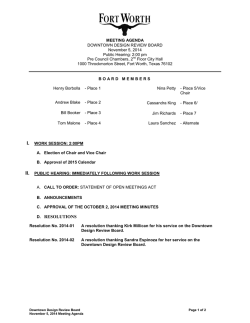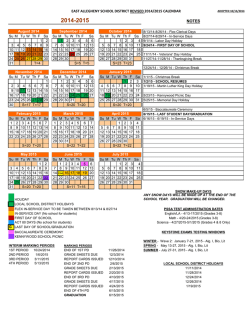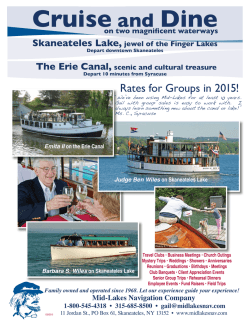
2015 State of the City Address Mayor Stephanie A
2015 State of the City Address Mayor Stephanie A. Miner Thursday, January 29, 2015 Good evening. Thank you all for joining me for the 2015 State of the City Address. My thanks to Monsignor Neal Quartier for that beautiful invocation, and to Councilor-AtLarge Pam Hunter for her introduction. I want to thank our volunteers from Seymour Dual Language Academy for leading us in the Pledge of Allegiance. Didn’t they do an excellent job? I also want to thank Bob Daino and the WCNY team for hosting us here this evening. Bob and the WCNY family are bringing a cutting edge approach to providing educational and entertaining public broadcasting for our community. Your commitment to this neighborhood, our city and the entire community is to be commended. I would also like to acknowledge the Near Westside Initiative. This beautiful facility highlights the progress that has been made in the Near Westside neighborhood over the last several years. I want to thank Marilyn Higgins, Maarten Jacobs and the entire team from Syracuse University and the Near Westside Initiative for their steadfast dedication to making place-based community and economic development work for the people of this neighborhood. I want to acknowledge members of the Syracuse Common Council: In addition to Councilor Hunter, Council President Van Robinson, Majority Leader Helen Hudson, Majority Whip Jake Barrett, President Pro-Tem Jean Kessner, and Councilors Khalid Bey, Bob Dougherty, Kathleen Joy, Nader Maroun and Chad Ryan. Also seated with the Council is City Clerk John Copanas. I also want to thank City Auditor Marty Masterpole for joining us tonight. Welcome to our City Court Judges in attendance this evening. We appreciate you being here. Welcome to Syracuse Schools Superintendent Sharon Contreras. Thank you for being here Superintendent. 1 I also want to welcome our Commissioners of Education. Welcome to members and representatives of our state delegation as well – Senator John DeFrancisco, Senator Dave Valesky, Assemblyman Bill Magnarelli, Assemblyman Sam Roberts and Assemblyman Al Stirpe. County Executive Joanie Mahoney and members of the County Legislature are in attendance as well. Thank you for being here tonight. __________ Being in this building tonight – this century-old warehouse turned state-of-the-art studio – we should be reminded that cities are always changing; always evolving. But they do not change on their own. This evolution, this progress and transformation is something people make happen. We are the city-makers. Collectively – our actions, our efforts – blend together to make and remake our city. After five years as Mayor, working each day with so many of you, so many passionate, tireless partners around this community to make this transformation happen, I think we can all honestly say that this work is incredibly challenging. Perhaps more so now than ever. Extreme financial distress, failing infrastructure, growing cynicism about government's ability to work for public good and not for political expediency. We are being put to the test like never before. Certainly, many of these challenges are global. These problems and frustrations exist all across our state and our nation. But being Mayor and working each day at City Hall it is evident that the most critical parts of daily life, the things that affect us all the most, are the things that are done by those who live and work in our city – in Syracuse – every day. And I’m not the only one who believes that. A very ambitious and successful politician was once asked about his career choices and he said, “I never had an interest in being a mayor, because that’s a real job. Mayors have to 2 produce.” Don’t I know it – Mayors and cities have to produce. By the way, that politician is SU alum and Vice President of the United States Joe Biden. When I asked him if he really said it or was he quoted out of context, he said, “You bet I said it; we do war and peace, you do everything else.” When Vice President Biden said that to me, he was communicating something we are all reminded of every time we bring our trash and recycling out to the curb, take a walk in the park or turn on the faucet: Cities have to work. Local government is where the rubber meets the road. The decisions we make have real and lasting impact on our lives. Because it is a real job, we cannot afford to be timid or make excuses. No, we must be bold, we must focus on the fundamentals, and we must have vision. Remember – we are the city-makers. Tonight I will talk to you about the progress we are making in our city today, and the work that must be done for Syracuse to thrive tomorrow. __________ What progress could be more important than that which we are making in our neighborhoods? All across our city neighborhoods we are seeing new projects, new culture, and new success stories. As the Near Westside continues its rise to a new future, we continue to see new leaps just to our east in downtown. Recent successes at the Pike Block, Merchants Commons, Dey’s Centennial Plaza and many others in the area demonstrate that downtown’s energy has spread beyond Armory Square. With a residential occupancy rate of nearly 100%, it is clear people crave the authentic and exciting lifestyle our downtown offers. In the last year alone downtown has seen 153 new market rate residential units come online – a 9% increase. Over the last five years we have seen the number 3 of downtown apartments increase by 43%. Currently there are 439 additional units planned or under construction. Clearly the numbers confirm what we all already know: downtown living is in high demand. This astonishing residential growth demonstrates the power creative adaptive reuse of our historic buildings can have. Bringing under-utilized historic architecture back to life is critical to the long-term success of our city. Perhaps the most obvious and exciting example of this opportunity is our beloved Hotel Syracuse. Over the last year, Syracuse-native Ed Riley and his Syracuse Community Hotel Restoration Company have continued to partner with the City and County to redevelop the Hotel Syracuse. The Syracuse Industrial Development Agency was successful in acquiring the property through eminent domain and transferring it to the hotel restoration group. The group is already underway with critical weatherization work, and will continue their work this year to fully renovate the historic building into a 261-room full service hotel. I want to thank County Executive Mahoney and the County Legislature for designating the Hotel Syracuse the official County Convention Center Hotel. I also want to acknowledge Alan Naples from M&T Bank for his willingness to take the lead on the lending that will make this project possible. And, of course, our thanks to Ed Riley for his courage and expertise in taking on this project – one that is so important to downtown’s economic and civic identity. __________ The last year has also seen a major paradigm shift in the ways we redevelop our neighborhoods and hold property owners accountable. 2014 was the most successful year yet in our partnership with the Greater Syracuse Land Bank. Created by the City and County in 2012, the Land Bank has been leading the state as the most active and successful land bank in New York. 4 In 2014 the Land Bank acquired 340 properties, bringing their total number of acquisitions to 507. Last year, in partnership with Home HeadQuarters, the Land Bank completed and sold ten residential renovations. An additional 30 rehab projects are planned, 13 of which are underway with Home HeadQuarters and 10 with Onondaga County. Last year the Land Bank completed 26 property demolitions, helping to remove some of the worst blighting influences from our neighborhoods. To date, the Land Bank has sold 94 properties. Collectively, the buyers of these properties plan to invest more than $5 million in renovations. These sales have generated nearly $1 million in revenue to fund the Land Bank's continuing operations. In the past it seemed I couldn’t visit a neighborhood without a citizen pointing out an eyesore property that had been abandoned by its owner. That story is now changing as citizens are increasingly pointing to former eyesores, now put back into productive use thanks to the Land Bank’s efforts. Meanwhile, the City’s new tax collection policies, in concert with the Land Bank’s activities, continue to create value for City taxpayers. As you can see, our more proactive strategy has led to significant annual increases in property tax collections. In the fiscal year ending in June of 2011 – the last fiscal year prior to the Land Bank’s startup – to the fiscal year that ended in June of 2014, our delinquent tax collections have skyrocketed from $3.4 million to $6.2 million. An 82% increase. Additionally, the Land Bank’s recent sales have returned properties to the tax rolls, and are estimated to generate new property tax revenues of approximately $170,000 a year. The Land Bank has big plans for 2015 as well. They have set goals to acquire up to 600 properties via tax foreclosure, and to sell 120 properties, returning them to productive use. They also plan to demolish approximately 40 structures. 5 Responding to concerns brought up by our City Councilors, the Land Bank has also recently announced an exciting new program, offering City firefighters, police officers, and Syracuse City School District teachers a 50% discount on houses located in the City of Syracuse. The Land Bank will discount the listing price of any 1 to 4-family home at the time of purchase for those who agree to occupy the home as their primary residence for a period of at least five years. I want to acknowledge Land Bank Executive Director Katelyn Wright, and Board members Dan Barnaba, Julie Cerio, Jim Corbett, Dwight Hicks and Vito Sciscioli. Thank you for your creativity and hard work in helping lift up our neighborhoods. __________ As we focus on redevelopment of our downtown and reinvestment in our neighborhoods, we must also keep an eye to the future of our city as a whole. Creating a holistic vision and establishing predictability and high standards for development is vital to our future economic and social vitality. Last year we adopted a brand new Comprehensive Plan for the City of Syracuse. The Syracuse Comprehensive Plan: 2040 is the most detailed and extensive municipal plan in our city’s history. That plan will act as a foundation for an exhaustive process to rewrite the city’s zoning ordinance. Our current code is a patchwork of land use policies and regulations dating back decades. The code is difficult to administer, challenging for citizens and business-people to understand, and in many ways is a mismatch for our goals for the city. With the help of a $300,000 grant from NYSERDA’s Cleaner, Greener Communities program, our planning team will spend the next two years crafting a new, simplified code that will promote sustainable development, walkable communities, high-quality design and predictability for developers and neighborhoods. 6 In the coming weeks we will convene a steering committee for this project comprised of citizens, Common Councilors, architects, planners and business people to help guide the process. To those of you who have advocated for this project and have already volunteered to participate, I want to thank you for your willingness to work with us on this community-based effort to beautify and strengthen our city. __________ Strengthening neighborhoods also means enriching that which connects them. Over the last year we have continued our efforts to embrace Onondaga Creek as a community asset. In October we opened the Outdoor Classroom space along Onondaga Creek in Kirk Park. This space will be used for enhancing recreational and educational opportunities in the park. The project was made possible through a grant from the New York State Department of State’s Local Waterfront Revitalization Program. I want to thank the state for their continued support of our efforts to improve community access and enjoyment of Onondaga Creek. Last year we were fortunate enough to receive a subsequent award through this program in the amount of $370,000 to construct another public improvement, this time on the shore on Onondaga Lake. Dubbed the Lake Lounge, this project will make the northern terminus of the Onondaga Creekwalk a signature location in our city. We will also continue our efforts, not only to improve the Creekwalk, but to extend it. This year we will begin the preliminary design process for Creekwalk Phase Two. The study area extends from the Creekwalk’s current southern terminus in Armory Square through the Southside and Kirk Park to Colvin Street. Community input will be crucial to the success of this planning effort. We will be announcing the first round of public meetings for this project next month. 7 __________ We cannot discuss neighborhood dynamics without discussing public safety. Public safety has been a constant and principal priority of my administration. As we review some public safety statistics, I am sure that we can all agree: when it comes to the most serious crime – homicide – one is too many. 2014 was another challenging year in this regard, with 22 homicides matching our annual total from 2013. These tragic crimes strike the public consciousness and amplify the social and economic distress our community grapples with. However, passionate and concerted efforts from both police and community groups are bearing positive results as well. From 2013 to 2014 we experienced decreases in a number of crimes: Vehicle thefts and aggravated assaults were both down 6%, larceny was down 8%, shots fired were down 11%, and burglaries were down 21%. __________ Aiding in our efforts to continue this hard-earned progress, a new class of police recruits will be hitting the streets in April, adding 32 new officers to the force. __________ Chief Frank Fowler and his administration have continually explored new programs and approaches that keep Syracuse on the innovative edge of public safety problem solving. In partnership with the City’s Research Bureau, the Syracuse Police Department has launched the Comprehensive Gang Model program through funding from the US Department of Justice. This program is addressing gang-related violence and criminal activity among youth in the Southside of Syracuse by providing alternatives to gang activity, and improving institutional capacity to address these problems by increasing multi-disciplinary coordination. __________ 8 The Police Department will also be rolling out new efforts to reduce gun violence in the city. The Problem Oriented Policing program, or POP, will use crime data to determine gun crime hot spots. Once the hot spots are identified, the dedicated POP team will develop and deploy various strategies in those areas, and use ongoing data analysis to measure the results of their interventions. This data-oriented strategy will enable our officers to systematically diagnose trends in gun violence. __________ We have also continued our efforts to use technology to improve public safety through our COPS cameras. In the past I have spoken about what the statistics tell us about the effectiveness of these cameras, but tonight I would like to put it in more human terms. In June of last year a latenight fire was reported in the 900 block of Butternut Street. The fire was reported, police and fire quickly arrived on the scene, and one occupant – Beverly Palmteer – was pulled from the home. She was taken to the hospital where she later died. Two COPS cameras are located in this area of Butternut Street, and the evidence produced by the footage led to the arrest and conviction of the perpetrator of this arson and homicide. Not only was this evidence critical to putting the guilty party behind bars, it also cleared two young men spotted near the incident of any wrong-doing. Stories like this demonstrate the power these tools can have for our community. Consequently we will be expanding this successful program in 2015. Thanks to grants from the Department of Justice and support from Assemblymen Magnarelli and Roberts, we will be adding 33 new COPS cameras in the Washington Square, Hawley-Green, Park Street and East Fayette Street neighborhoods. I want to thank the Assemblymen for their support in securing the funds to make this possible. __________ 9 Our community policing efforts continue as well, with an improved police satellite office location in Schiller Park, as well as a brand new satellite office coming to Hawley-Green. In 2015 we plan to extend the impact of our police storefronts with an additional satellite facility at the Southwest Community Center, which we plan to open by this summer. I want to thank Chief Fowler, the Deputy Chiefs and all of our officers for their continued efforts to protect our city. __________ Just as fundamental to the quality of life in our city neighborhoods as public safety is public education. There is no question this is an extremely tumultuous time in urban public education, not only in our district, but across the state and the nation. Issues of student discipline, the difficulties of implementing new Common Core standards, the tension that has stemmed from a new teacher evaluation system. All of this on top of the challenges urban schools have faced every day for many years. These issues are complex and controversial, and are wrapped in the passion that comes with anything that involves protecting the future of our children. We should be honest about that. What we should also be honest about, is that we will not conquer these challenges by placing blame. Scapegoating teachers will not solve these problems. Nor will pointing fingers at administrators, or parents, or anyone else. Drawing battle lines only guarantees failure. Our moments of greatest adversity must inspire our highest sense of unity. We must use this time of challenge as a force to bring us together, not tear us apart. __________ Effectively cultivating unity means celebrating the successes we have already achieved together. The first phase of the Joint Schools Construction program delivered successful projects at the Institute of Technology at Syracuse Central, Fowler high School, Dr. Weeks School and HW 10 Smith School. In the last year we have moved into Phase Two of JSCB, and just two weeks ago we announced the release of a request for proposals for program management services. Our goal is to complete renovation projects at 14 schools with a budget of up to $300 million. Renovations at the schools you see here will continue the progress have made in providing our children with the twenty-first century facilities they deserve. __________ When the topic of school performance comes up, undoubtedly the first thing mentioned is graduation rates. We all know the graduation rates in our district are not where we want them to be. But as these numbers increase, however incremental the progress may seem, it is important that we mark a positive direction. The New York State Education Department has released the latest high school graduation data. The Syracuse City School District four-year June graduation rate increased to 52% and the August graduation rate to 56%. It is the first time since New York State adopted its new graduation rate calculation more than six years ago that the City School District graduation rate has exceeded 50%. The graduation rate increased at four of our high schools, with the Fowler community committed to turning around its graduation rate of 30%. The Institute of Technology at Syracuse Central saw its August graduation rate climb to 82%, while at Corcoran the rate reached 67%. Henninger and Nottingham saw the largest percentage increases in their August graduation rates as they improved to 56%, and 62% respectively. __________ As we draw some optimism from these numbers, we should remember these numbers represent people. And these people, these students who graduate from Syracuse City Schools, have 11 a world of opportunities before them, not the least of which is the possibility of a free college education thanks to the support of Say Yes. Say Yes to Education is now in its 7th year providing our students with comprehensive supports, including the promise of free college tuition to one of nearly 100 colleges and universities for those who meet admission requirements. Since 2009, more than 2,600 Syracuse City School District graduates have enrolled in college with Say Yes support. For those attending public colleges and universities, the Say Yes Endowment, Say Yes Foundation, and individual donors have provided more than $4.5 million in direct tuition assistance. And more than 250 Say Yes Scholars have graduated from four-year colleges and universities. Two of those students are here this evening. Shaquila Johnson and Tess O’Leary, both Fowler graduates, have also recently graduated from college with the support of the Say Yes Scholarship program. Shaquila recently graduated from Buffalo State University, and Tess recently graduated from Hobart and William Smith College. I’d like to ask Shaquila and Tess to stand and be recognized. Their stories underscore the importance of solidifying the Say Yes Endowment Fund. Say Yes to Education will only be a priority if we make it a priority. This past fall Superintendent Sharon Contreras, County Executive Joanie Mahoney and I hosted the Back to School Gala to benefit Say Yes to Education. The event attracted more than 250 generous members of our community, and we raised more than $130,000 for the Endowment. I want to thank Superintendent Contreras, County Executive Mahoney and everyone from our community who came to support Say Yes to Education and the children of our city. __________ 12 Whether we’re talking about strengthening our neighborhoods, improving public safety or investing in our schools, undoubtedly the dollars and cents matter. It is no secret that our city has been in an ongoing fiscal storm. The year ahead will be no different. Over the last decade the City’s healthcare costs have increased 86%, while our pension costs have jumped by a staggering 355%. No, that’s not a mistake on the prompter: 355%. Exploding personnel costs combined with flat state aid and negligible increases in assessable tax base and tax levy means the slow decline in our fund balance continues. __________ These financial difficulties make it harder for us to invest in the infrastructure we know is so critical to making our city work. With the City’s debt limit, tax cap and shrinking fund balance, we are significantly constrained in our ability to keep up with the demands of century-old infrastructure systems. Investing in infrastructure isn’t a project or temporary initiative; it means creating a platform on which to build the future success of our community. It provides for basic needs and supports our quality of life, and it fuels robust, equitable and sustained economic growth. Robert Puentes, senior fellow with the Brookings Institution, put it this way: “Concrete, steel and fiber-optic cable are the essential building blocks of the economy. Infrastructure enables trade, powers businesses, connects workers to their jobs, creates opportunities for struggling communities and protects the nation from an increasingly unpredictable natural environment….infrastructure is the backbone of a healthy economy.” These precepts have always been true of cities. Keeping up with our infrastructure needs is daunting, and pushing ourselves to the cutting edge will be even harder. __________ 13 The maintenance needed on our roads and bridges is just the most obvious example of infrastructure need. But that is just a sliver of the entire infrastructure picture. Part of what has led to our infrastructure crisis is that what is out of sight tends to stay out of mind. That is, until this happens. 2014 was a milestone year in this regard. Last year we experienced 391 separate water main breaks – an all-time record. This number was a 10% increase over the previous year, a 41% increase over 2011, and a 46% increase over the average from 2006 thru 2013. During a five-day period from January 29 to February 2 of last year we had 22 different breaks, the repair of which cost the City more than $205,000. Both the numbers and the images are astounding. A recent service call in the Inner Harbor caused our Water Department crews to discover an active pipe dating back to 1893. The presence of water pipes from 1893 in a part of our city experiencing the birth of a brand new mixed-use neighborhood exhibits how our aging infrastructure is a mismatch for our twenty-first century needs. The frequency of breaks and the limited nature of our resources have dictated a pay-as-itbreaks approach to water service, but we are determined to do better. Our Water Department has just recently kicked off an effort to develop an Asset Management Plan for the City’s water system. This plan will detail system needs, prioritize critical investments, and enable us to begin shifting from reactive emergency repairs to proactive system improvements. I want to thank Commissioner Debi Somers and our Water Department crews for their persistence and tenacity in the face of such challenges. __________ 14 A part of our infrastructure system talked about even less than what exists below our feet is what we refer to as special lighting. Special Lighting Districts are those areas in the City that have petitioned the Common Council to allow for street lighting different than standard lighting, and may typically be identified by decorative features or underground wiring. With the benefit of this special lighting come additional costs which are placed on the tax bills of the property owners within these districts. The Common Council has asked my administration to evaluate the state of these districts and their financial impacts. As a result we have undertaken extensive research to accurately inventory all special street lighting in the city and calculate the true costs. 134 Special Lighting Districts have been created over the past 100 years, and for the most part, charges for these special street lights have never been adjusted to their actual costs. The City’s bill from National Grid for this lighting is more than $1.9 million annually, but property owners in these districts are only charged about $223,000 a year. That $1.7 million gap is made up by all other City taxpayers, who do not enjoy the benefits of this special lighting. We plan to consolidate the total number of districts throughout the city, and will be working with the Council to phase in the increases in special lighting charges required to cover the districts’ costs. I want to acknowledge the city staff members who have put so much work into this project, and thank the Common Council for their willingness to take this issue on. __________ This new revenue will provide us the opportunity to enhance infrastructure investment in our budgeting process. I plan to create a dedicated infrastructure fund, as part of the City Capital Improvement Program, which will be supported by these new revenues. This fund will enable us to 15 complete more proactive infrastructure improvement projects, and will demonstrate our local commitment to building our city for the future. __________ Modern infrastructure is more than roads, bridges and pipes. It includes information technology as well. This is an area in which we have made significant and continuous progress over the last several years. __________ Last year I announced the deployment of a new smart phone app called Whoosh. Whoosh allows users to pay for parking spaces remotely using their phones, without having to go back to your car or handle cash. The app was rolled out in the downtown area in August, and citywide in November. Since the app was first made available in August, there have been nearly 10,000 transactions through Whoosh, with each month seeing sharp increases in usage. __________ We also continue to use technology to make the city’s internal operations more efficient. PeopleSoft is a new software system that replaces the City’s legacy financial and budgeting systems, including general ledger, accounts receivable and billing. The City has developed a partnership with Onondaga County for PeopleSoft services, which provides the benefit of the County’s experience and knowledge, while achieving cost savings to the City. PeopleSoft is used extensively in the public sector across New York State and beyond, and is designed to reduce paper-based transactions, increase productivity and improve financial management. We have already progressed into phase two of PeopleSoft implementation, and the system is scheduled to go live in July of this year. __________ 16 Technology plays a more prominent role in our society and economy than ever before. One thing that has grown more apparent in recent years is that high speed internet will be as influential in the next century as electricity was in the last. This information infrastructure connects us, and facilitates the movement of ideas and products. Communities without fast, reliable and affordable broadband service will be left behind, and unfortunately the private market is not living up to those standards. That is why last year I announced the launch of a City broadband initiative to explore models for municipal delivery of high-quality, affordable internet service. We have established a broadband leadership committee, comprised of experts from the partners you see here, to help guide us through this exploration. Recently this group reviewed proposals from world-class consultants who are specialists in this field, and in the coming days we will be announcing the selection of a group to complete a feasibility study that outlines options our community has in pursuing this endeavor. I want to thank all of our partners for their willingness to participate in this effort to make Syracuse a leading digital city. __________ Our search for additional outside resources has recently brought us an exciting new opportunity to generate creative approaches to solving our most intractable problems. Just last month the City was awarded $1.35 million over three years from Bloomberg Philanthropies to create the first-ever Office of Innovation within City Hall. Syracuse is one of just 14 cities awarded in this highly competitive program. This grant funding will allow our city to build a dedicated innovation team, or i-team, and leverage it to develop and deliver bold new solutions to our most pressing problems. 17 In addition to funding we will also receive team training, one-on-one coaching and opportunities to connect with peer cities. Innovation teams function as in-house innovation consultants, able to move from one priority to the next, using a data-driven process to assess problems, generate new interventions, develop partnerships, and deliver measurable results. This grant is an acknowledgment that Syracuse is embracing innovation and will help us take the next steps in building our local capacity to innovate. The first area of focus for the Innovation Team will be infrastructure. The team will be focused not just on creative solutions to supporting particular parts of our infrastructure, but also on the potential for integration between infrastructure systems, and imaginative ways to spur investment and modernization. We will be hiring the director for this new office next month, with the addition of other team members quickly to follow. I want to thank Mike Bloomberg and the team at Bloomberg Philanthropies for recognizing the creative energy of our community and for making this investment in the future of our city. __________ Now, when this building was first built I’m sure no one conceived of what would be happening here one day. Time passed, the world changed, and this building grew tired. But people decided that in order for this building to keep working – in order for this place to thrive and succeed in the future – creative thinking and investment was required. Yes, this meant investing in new walls, new lights, new technology. But this was also an investment in the future. Just as investing in neighborhoods, and schools, and in modern infrastructure are investments in the future of our city and those who live here. 18 Remember – meaningful change does not happen on its own. We must decide what sort of city we give to future generations. Will we live up to the legacy of the audacious visionaries who built the Erie Canal? The railroads? The massive lines that bring clean water to our city? That is our inheritance. We must be willing to galvanize the success of the next generation, and to continue to make this city work. I want to thank all of you for your partnership, for the work you do each day to make our city work, and for being here this evening. Goodnight. 19
© Copyright 2024
